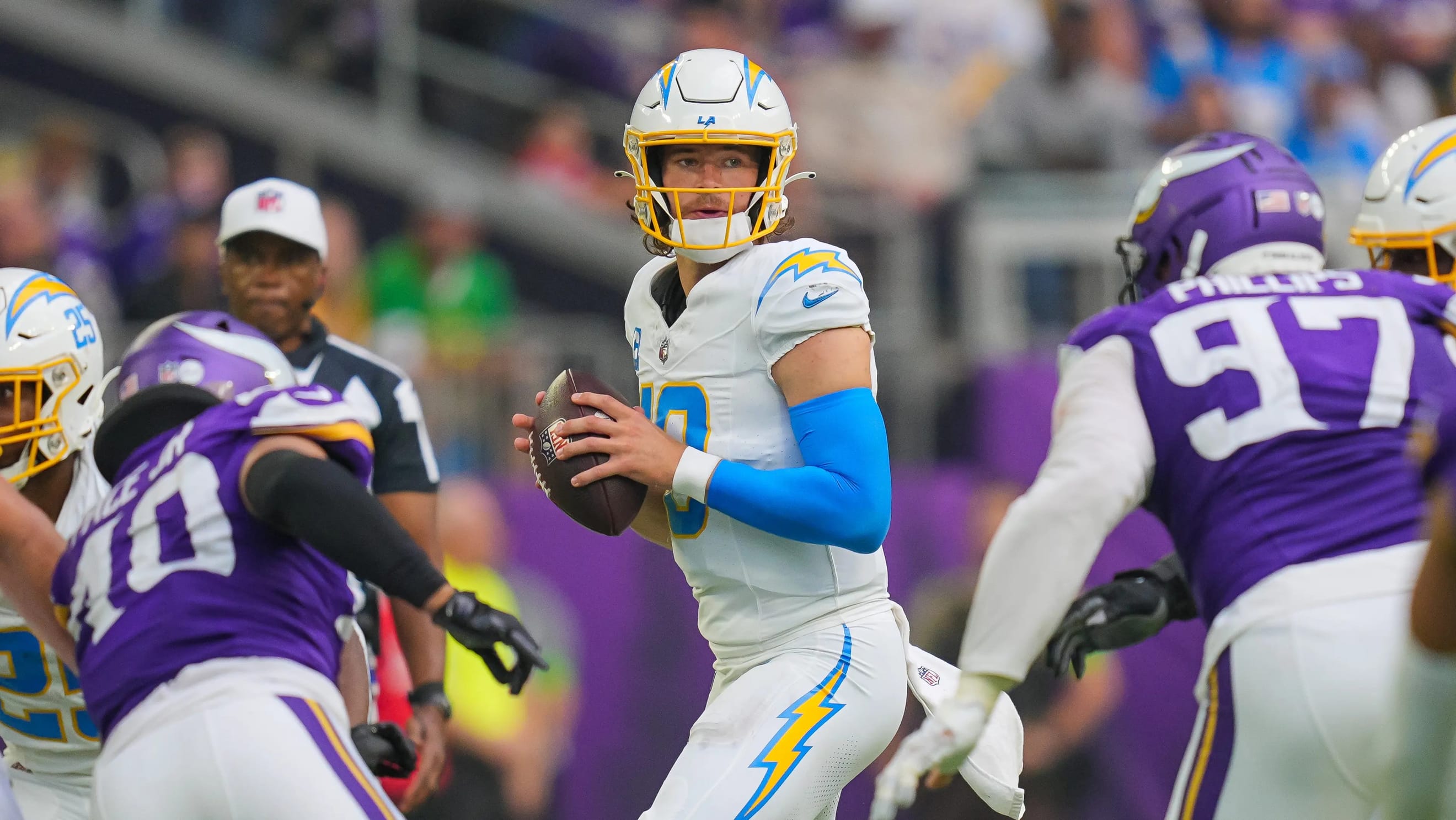
Quick Slant: TNF - Within the Vast Band Between Good and Bad
Mat Irby’s Quick Slant
The Chargers are 4-3 but feel like a team on a slow spiral out of control. Despite losing all-everything LT Rashawn Slater before the season’s outset, they came to the gates like the best team in the league through the first three weeks. They tore up the AFC West, starting with the conference champs in Brazil in Week 1, then cruised past the Raiders and dispatched the Broncos, who are a contender for the division crown. The Harbaugh effect had clearly taken hold; the Chargers had swiftly evolved from a perennial disappointment to a team that sweated every detail, executed every fundamental, and squeezed the best out of whatever they had. And just like that, they were contenders.
But since, something has been amiss. Sure, LT Joe Alt and RB Omarion Hampton sustained serious injuries, and breakout WR Quentin Johnston was banged up a little. But it’s more than that. The Chargers’ defense has performed very differently over the past four weeks compared to the first three, dropping from fourth in defensive EPA/play and first in defensive success rate in the first three games to 29th in EPA/play and 25th in success rate in the last four.
Elsewhere, the Vikings were one of the NFL’s darlings in 2024, emerging with upstart QB Sam Darnold out of the ashes. Darnold crashed and burned to end the season in 2024, but most had him well outside the MVP race anyway; all credit went to HC Kevin O’Connell, as Darnold was reduced to a “system quarterback” while O’Connell was given Coach of the Year. As such, many assumed sophomore first-round QB J.J. McCarthy, returning from an injury that cost him his entire rookie season, would easily replicate most of what Darnold had done, if not all, and Darnold would regress to his previous pre-Vikings state in Seattle steel blue.
Today, it feels like Darnold deserved more credit after all. He’s third in the league in EPA + CPOE Composite in Seattle, while McCarthy, now injured, led an uneven attack through the first two games (150.1 passing yards (paYDS), 1 TD, 1.5 INTs per game) and is now being slow-played back from injury, possibly because longtime retread QB Carson Wentz gives them a better chance to win anyway.
In some strange way, each team feels better than their record would indicate, and yet, each also feels as if they are lucky to still have a puncher’s chance. Perhaps each lives within that vast band between good and bad that NFL parity brings us annually, and perhaps they will ride a wave of variance all year that will keep them mysterious until the playoff roll call is taken. Either way, the stakes are already huge.
Vikings
Implied Team Total: 20.75
In fantasy football, we seek explosive offenses; this we know. We also seek poor defenses; this may be more subconscious. Few teams live in the quadrant where these coexist—Dallas, the superlative, as well as Buffalo, Washington, Pittsburgh, and a few others along the fringe.
Others live in the inverse—the less desirable composite of subpar offense and excellent defense. These make less attractive scenarios for fantasy in general. This year, three teams are entrenched in this quadrant thus far: Cleveland, Houston, and Minnesota.
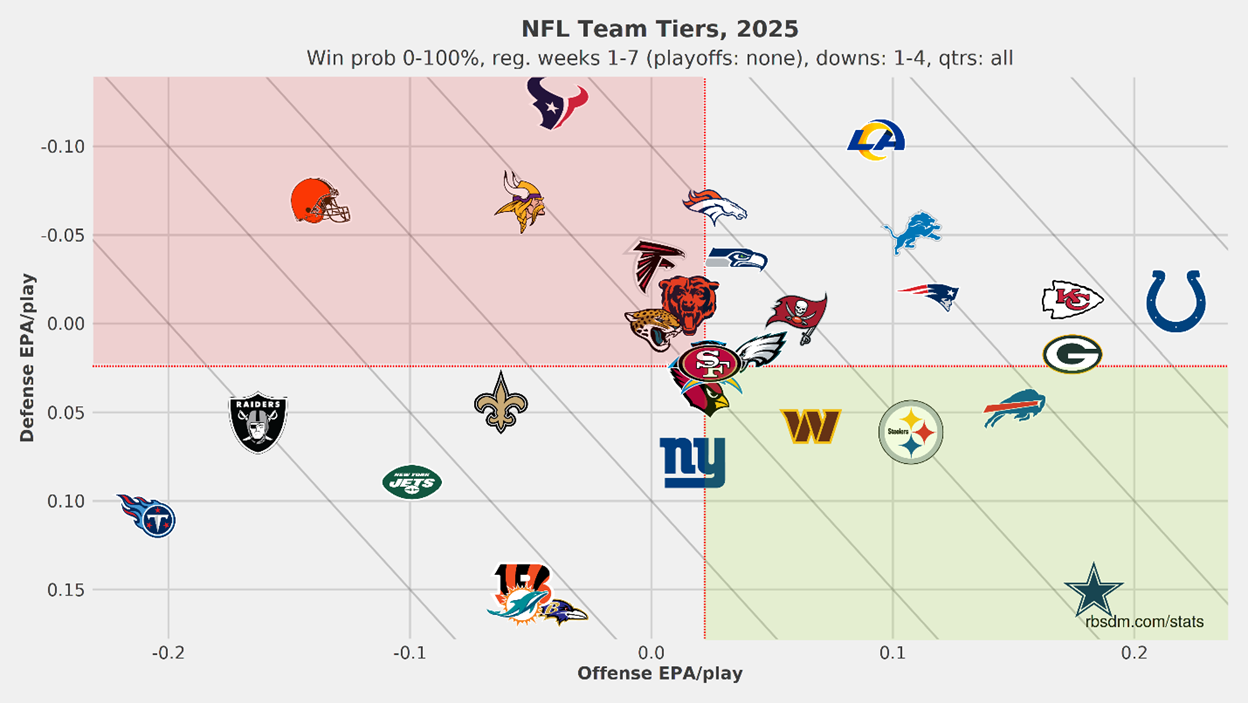
As a result, and along with their contentment sticking to a below-average pace (27.4 seconds to snap, T-20th), the Vikings have only run 369 plays this season (30th). They are relatively pass-heavy, however, throwing on 61% of their plays (T-6th). They are one of nine NFL teams to appear pass-heavy regardless of circumstance, with a +0.3% pass rate over expected (PROE, 9th).
McCarthy began the season as the unquestioned starter but suffered an ankle injury in Week 2. The fact that he was not placed on IR seemed to indicate that the Vikings anticipated no later than a Week 7 return. Still, strangely, McCarthy has been made the emergency QB for the second week in a row, prompting speculation that McCarthy is healthy enough to play, but the team would prefer to ride with Wentz instead.
From a real-life perspective, this is easy to understand, even if publicly disingenuous. Wentz has a +0.116 EPA + CPOE Composite, according to rbsdm.com (13th).
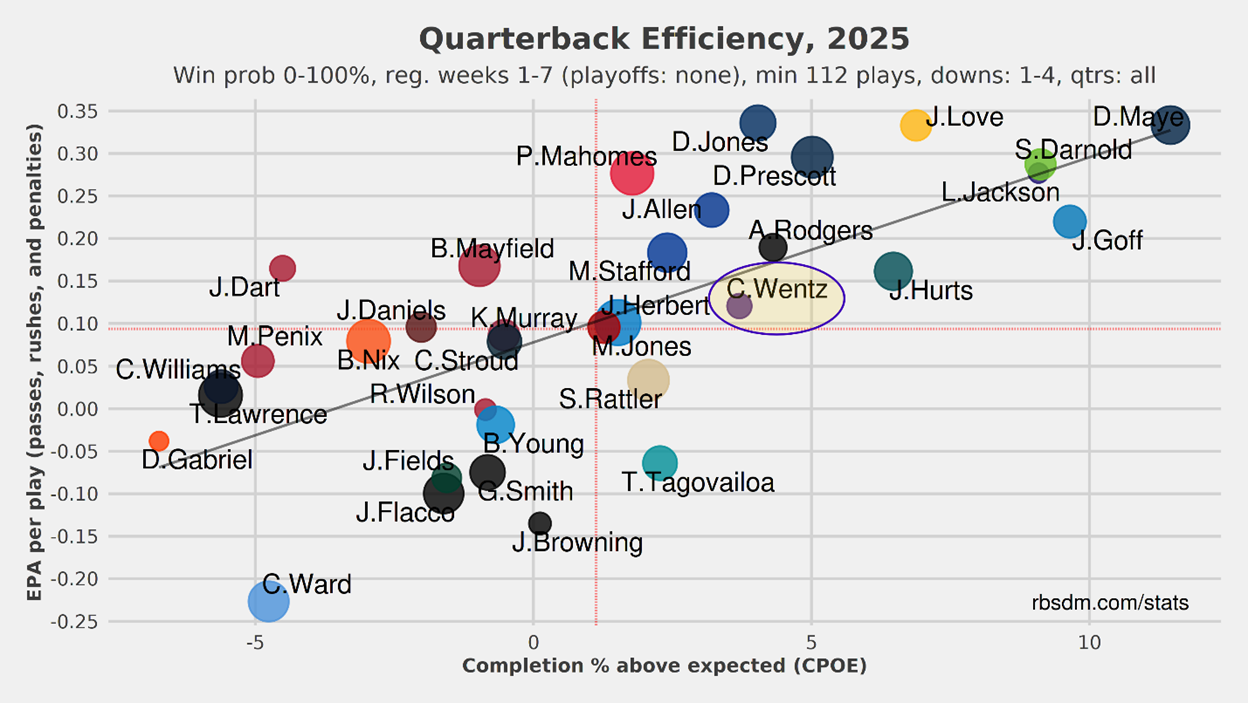
McCarthy no longer has enough plays to qualify for the table, set at 112 plays, but through two weeks, McCarthy was at -0.013 EPA + CPOE Composite (32nd), only ahead of Cam Ward, who had just finished his first two career starts for the worst team in the league.
Per game, Wentz has outpaced McCarthy in nearly every category. According to RotoViz stats, Wentz has attempted 39 passing attempts per game, throwing for over 100 passing yards (paYDs) per game more than McCarthy, and about half an interception fewer per game.

McCarthy shows up as a more active and more effective runner, which we like for fantasy, but Wentz has more than made up for it in the aggregate, scoring 18.32 fantasy points (FP) per game (20th), over three full FP/G more than McCarthy.
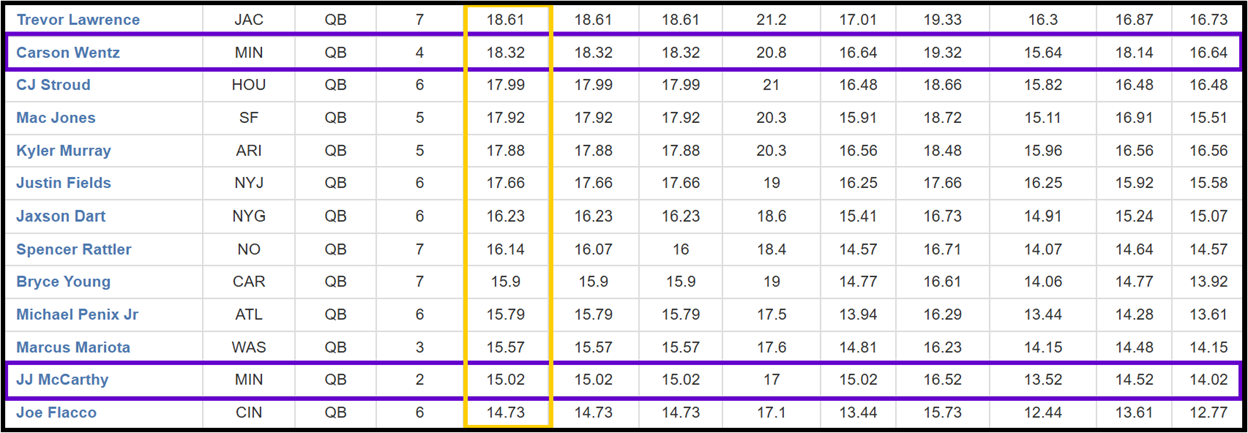
Since taking over in Week 3, Wentz has 165 dropbacks (14th) and 142 passing attempts (paATTs, 15th). The long-time narrative on Wentz is that he favors throwing to TEs; since Week 3, he has 14 paATTs to players lined up inline (T-21st), and paATTs to the slot (T-14th), so that hasn’t borne out, despite having a strong TE in T.J. Hockenson.
Since Week 3, WR Justin Jefferson is the Vikings’ leading target-earner with a market share of 26.5%, followed by WR Jordan Addison with 20.3%, and Hockenson with 17.7%. They are the only three Vikings with more than a 15% share in the past five weeks.
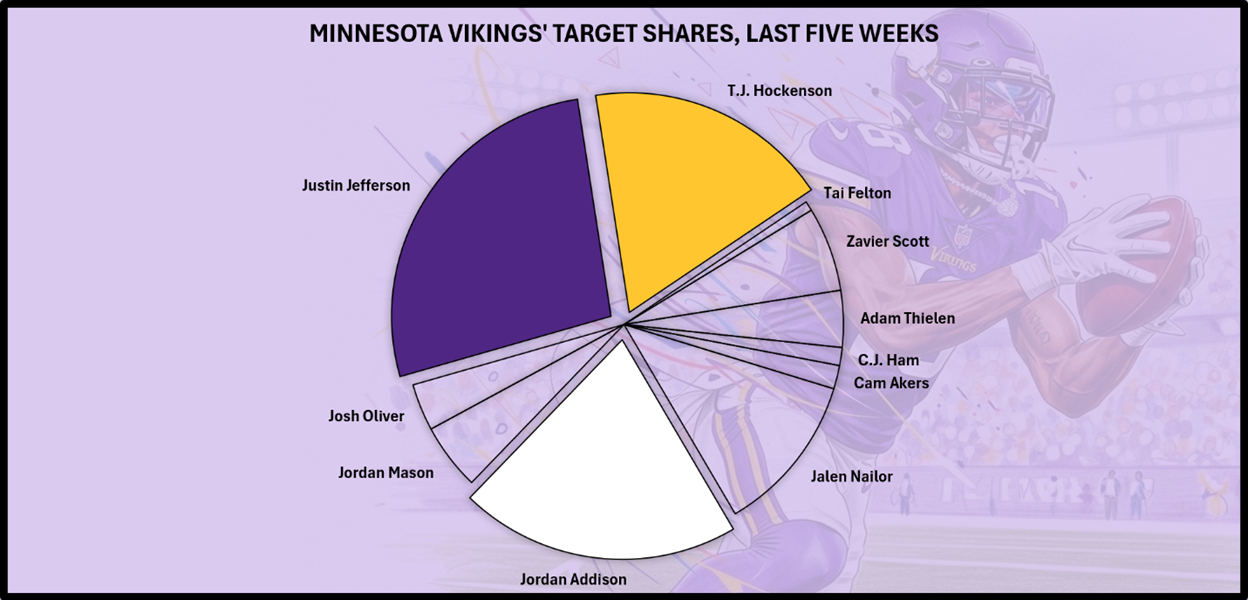
By comparison, Jefferson had a 31.7% market share in the first two weeks, but this was while Addison was serving a suspension, so this is not apples-to-apples.
All told, Jefferson is still at 27.7% for the season. This is still relatively in line with his career market share numbers, other than his injury-plagued 2023, since his rookie season in 2020. Last year, Jefferson was at 26.9% and finished third in PPR. This season, he ranks 18th. Based on RotoViz’s expected points model, Jefferson’s dip in expected points (EP) is minimal, as he has fallen from eighth to 12th in EP/G. But his fall in fantasy points over expected (FPOE) per game has been significant, as he has tumbled from 18th to 44th. Jefferson’s never had an FPOE/G lower than 2.6, but he’s at just 1.0 this season. This is all very small-sample stuff, and FPOE can catch up in a hurry if Jefferson breaks some big plays and scores more TDs.
Based on a simple TDs/Yards TDOE model, Jefferson is becoming a big-time positive TD regression candidate.
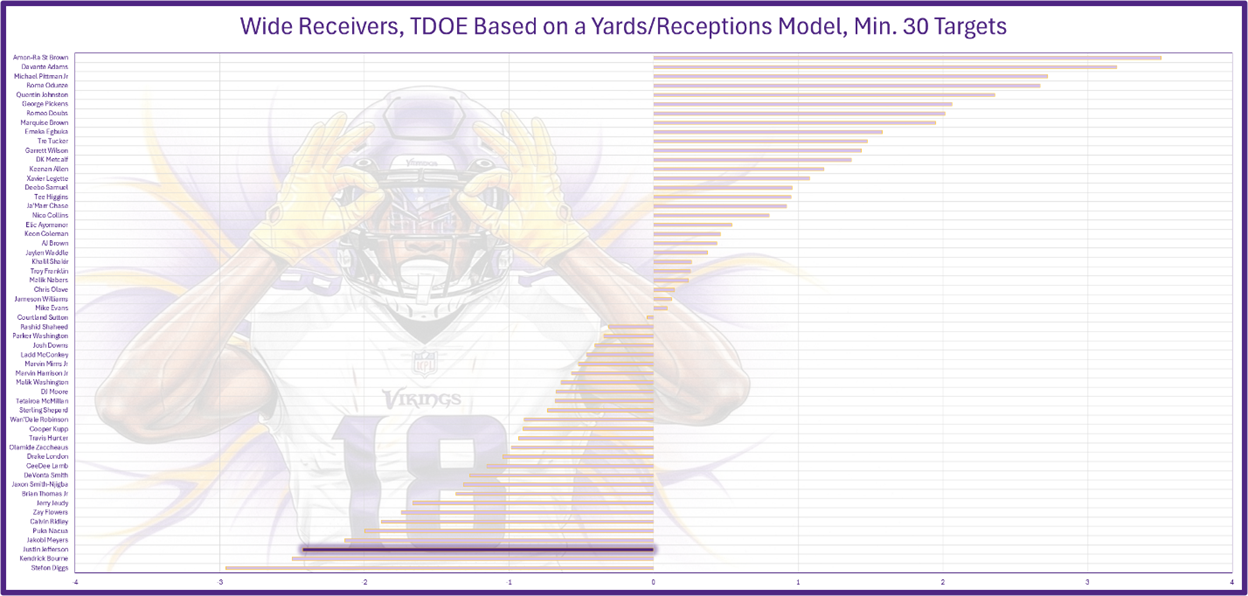
Efficiency has been a problem for the Vikings in 2025 in general, as they rank 11th in offensive success rate, indicating they can move the ball and gain first downs effectively, but they rank just 26th in offensive EPA/play. This is the widest disparity in favor of offensive success rate over offensive EPA/play in the league.
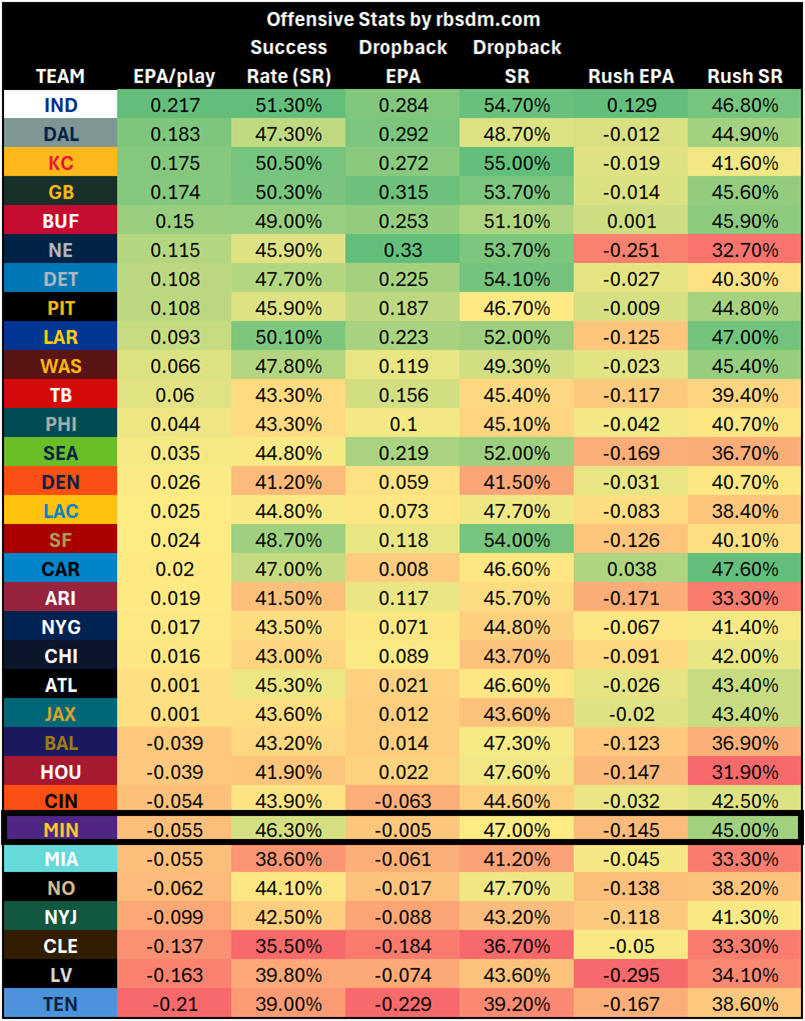
The Vikings have the most offensive giveaways per game, and they rank in the top ten in sacks taken and penalties. This can drag efficiency; they don’t offset this with enough TDs and big plays, so the Vikings are likely stringing together effective drives, then taking a negative play, or possibly consecutive negative plays, that stall drives out.
The Chargers are better in pass defense, and, in particular, they rank fourth in defensive success rate on dropbacks.
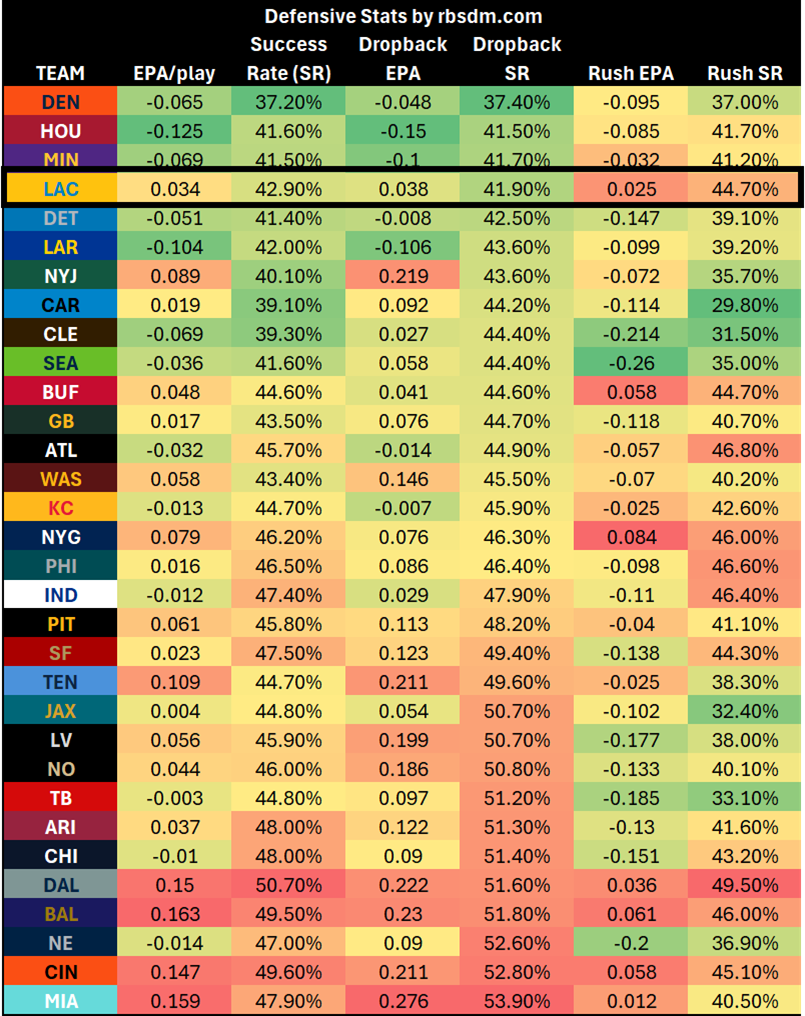
They use a zone defense at a 78.5% rate (7th). They use a two-high safety alignment at a 54.8% rate (8th). This is generally a formula for a bend-don’t-break defense, which invites runs up the middle into soft boxes and short zone beater routes like slants and curls and limits big plays and yards after catch (YAC). This puts the pressure on an offense to play mistake-free, something the Vikings haven’t been able to do yet (although their chances are better with Wentz than McCarthy, most likely).
Against the types and rates of coverage the Chargers run, Wentz has a slightly unfavorable matchup, according to Fantasy Points’ coverage matchup tool, where he ranks 16th. This makes sense because, even as he is better than McCarthy at mistake-free football, this is not Wentz’s specialty historically either.
According to Fantasy Points’ coverage matchup tool, Hockenson should easily benefit the most from the types and rates of coverage the Chargers use; his is the best TE matchup of the week based solely on this criterion. Jefferson should also have a relatively favorable matchup based on alignment types.
Based on specific personnel matchups, the Chargers appear slightly more competitive. According to PFF’s player-based matchup tool, Jefferson and Hockenson’s matchups are considered fair, and the rest are poor. The Chargers’ three top CBs all rank in the top 25 in PFF position grade.
Minnesota’s offensive line draws a neutral matchup in pass-protection, but in run-blocking, the Vikings should have an edge.
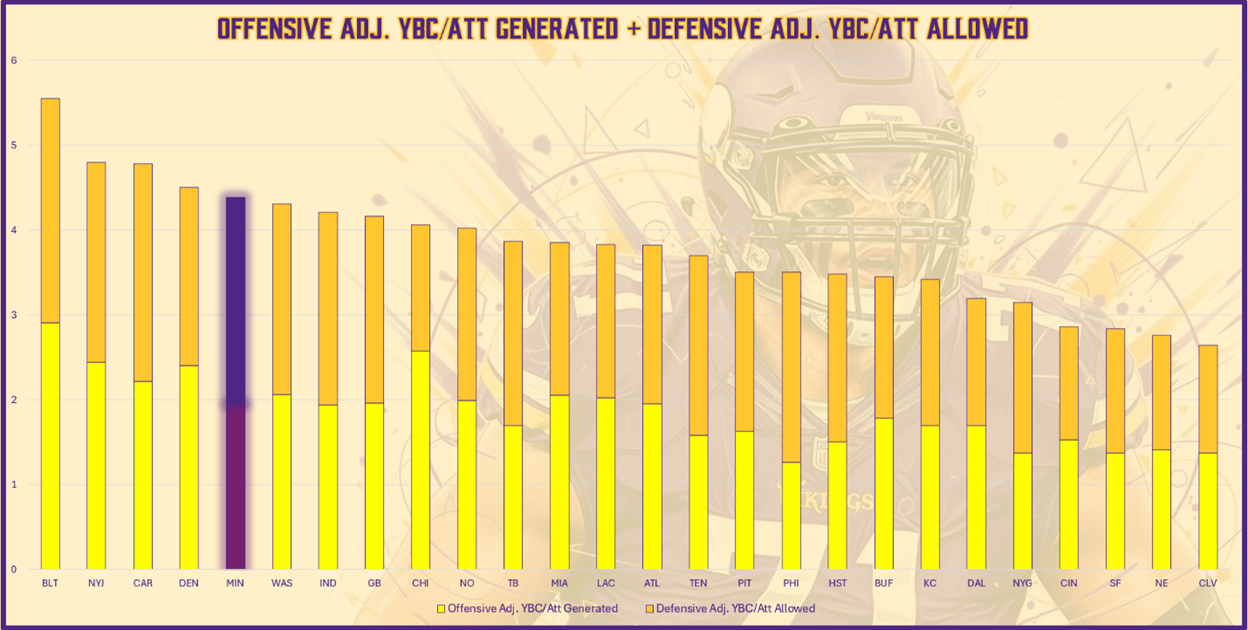
Veteran RB Aaron Jones has had his practice window opened after having battled a hamstring injury he sustained in Week 2. Technically, Jones is listed as questionable for Thursday, but as of this writing, nothing has been clarified. I would consider Jones less likely to play on a short week, but we should certainly watch the reports throughout the day.
If Jones doesn’t play, the Vikings’ backfield is somewhat crystallized. RB Jordan Mason is the primary workhorse back with 62% of Minnesota’s rushing attempts since Week 3, but a very low target share at just 5%. Generally, RB Zavier Scott has served as a better pass-catcher and has drawn a 7% share, but Jones is a legitimate threat to be a real pass-catcher out of the backfield, as he has five seasons with at least a 12% market share and over 45 receptions. At this age, and with Mason on the roster, Jones should be more or less a third-down specialist.
But in this game, against this defense, the Vikings may opt for the hammer anyway. There is nothing flashy about Mason in the Vikings’ offense; he’s a down-eater—a yard-churning try-hard back with middling explosiveness.
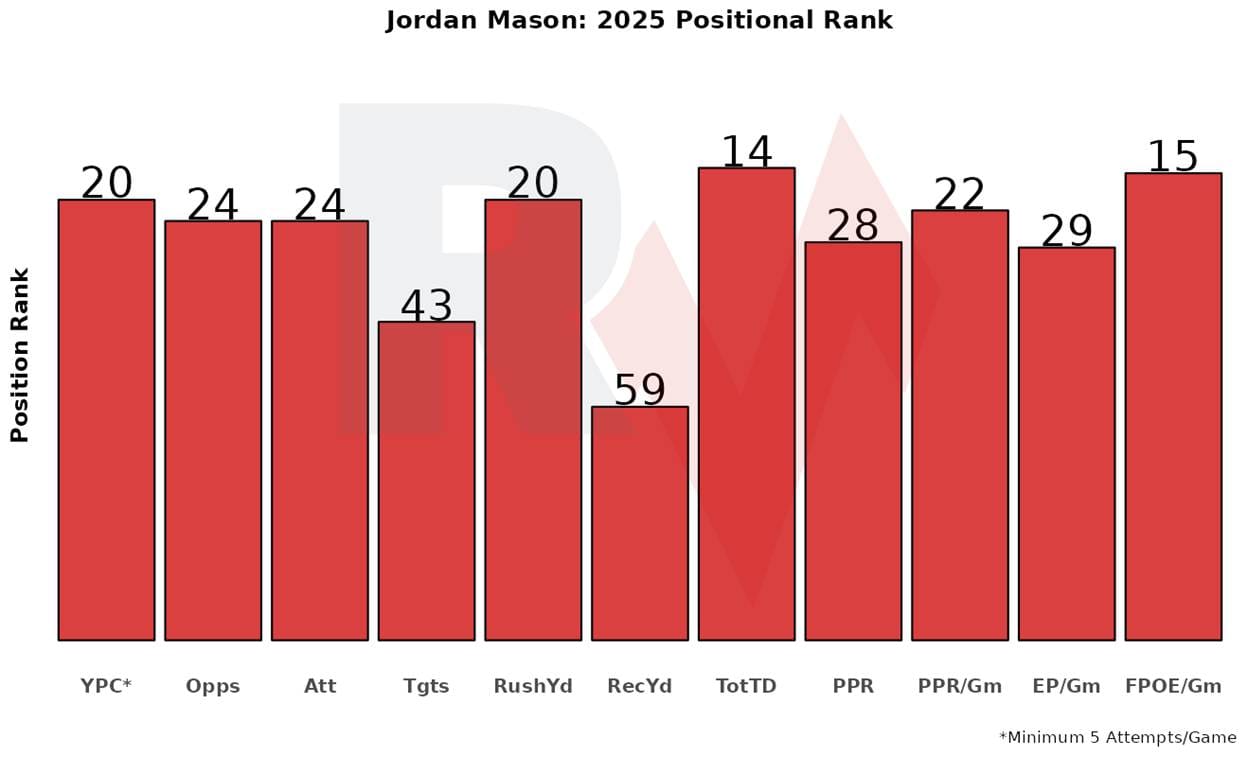
For what it’s worth, the Chargers make for a decent matchup for RBs. Still, the main thing that keeps him down is the lack of opportunities in this low-volume offense that earns few plays and points, many of them in the passing game. If Jones is active, the workload ruptures even further, making it a real gutsy call to use either Mason or Jones, especially with a low implied team total for an underdog on the road.
If Jones is inactive, Mason becomes slightly more attractive. Still, this scenario requires us to believe the Vikings will discipline themselves to stick to the run, against their nature, and grind it out with L.A. And even then, they have to stay in the game, because Mason is game-script dependent no matter what; an early deficit could spell doom.
Scott is listed as questionable with a wrist, and even FB C.J. Ham, who earns some passing-game work, is listed as out with a hand injury. The real fly in the ointment could come if LT Christian Darrisaw, an excellent player, is ruled out. He is officially questionable, but he’s logged DNPs all week. If Jones is active and Darrisaw is out, I’d hesitate to use Mason if I could help it.
